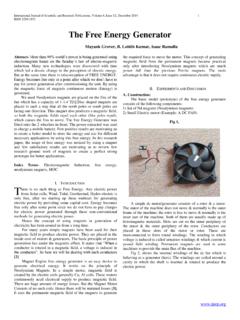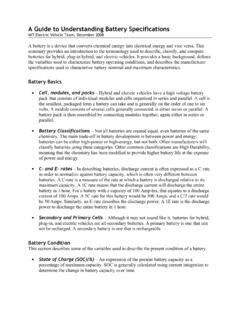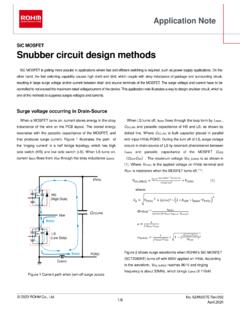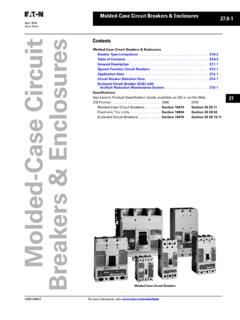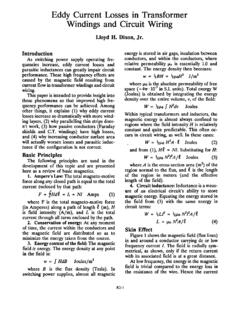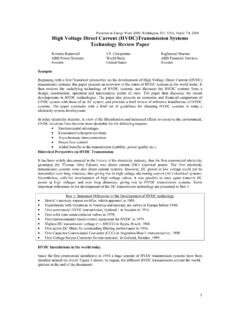Transcription of MT-087: Voltage References - Analog Devices
1 , 10/08, WK Page 1 of 18 MT-087 TUTORIAL Voltage References INTRODUCTION Voltage References and linear regulators have much in common. In fact, the latter could be functionally described as a reference circuit , but with greater current (or power) output. Accordingly, almost all of the specifications of the two circuit types have great commonality (even though the performance of References is usually tighter with regard to drift, accuracy, etc.). In many cases today the support circuitry is included in the converter package. This is advantageous to the designer since it simplifies the design process and guarantees performance of the system. Voltage References have a major impact on the performance and accuracy of Analog systems. A 5 mV tolerance on a 5 V reference corresponds to absolute accuracy which is only 10-bit accuracy.
2 For a 12-bit system, choosing a reference that has a 1 mV tolerance may be far more cost effective than performing manual calibration, while both high initial accuracy and calibration will be necessary in a system making absolute 16-bit measurements. Note that many systems make relative measurements rather than absolute ones, and in such cases the absolute accuracy of the reference is not as important, although noise and short-term stability may be. Temperature drift or drift due to aging may be an even greater problem than absolute accuracy. The initial error can always be trimmed, but compensating for drift is difficult. Where possible, References should be chosen for temperature coefficient and aging characteristics which preserve adequate accuracy over the operating temperature range and expected lifetime of the system.
3 Noise in Voltage References is often overlooked, but it can be very important in system design. Noise is an instantaneous change in the reference Voltage . It is generally specified on data sheets, but system designers frequently ignore the specification and assume that Voltage References do not contribute to system noise. There are two dynamic issues that must be considered with Voltage References : their behavior at start-up, and their behavior with transient loads. With regard to the first, always bear in mind that Voltage References do not power up instantly (this is true of References inside ADCs and DACs as well as discrete designs). Thus it is rarely possible to turn on an ADC and reference, whether internal or external, make a reading, and turn off again within a few microseconds, however attractive such a procedure might be in terms of energy saving.
4 Regarding the second point, a given reference IC may or may not be well suited for pulse-loading conditions, dependent upon the specific architecture. Many References use low power, and therefore low bandwidth, output buffer amplifiers. This makes for poor behavior under fast transient loads, which may degrade the performance of fast ADCs (especially successive approximation and flash ADCs). Suitable decoupling can ease the problem (but some References oscillate with capacitive loads), or an additional external broadband buffer amplifier may be used to drive the node where the transients occur. MT-087 SIMPLE DIODE References In terms of the functionality of their circuit connection, standard reference ICs are often only available in series, or three-terminal form (VIN, Common, VOUT), and also in positive polarity only.
5 The series types have the potential advantages of lower and more stable quiescent current, standard pre-trimmed output voltages, and relatively high output current without accuracy loss. Shunt, or two-terminal ( , diode-like) References are more flexible regarding operating polarity, but they are also more restrictive as to loading. They can in fact eat up excessive power with widely varying resistor-fed Voltage inputs. Also, they sometimes come in non-standard voltages. All of these various factors tend to govern when one functional type is preferred over the other. Some simple diode-based References are shown in Figure 1. In the first of these, a current driven forward biased diode (or diode-connected transistor) produces a Voltage , Vf = VREF. While the junction drop is somewhat decoupled from the raw supply, it has numerous deficiencies as a reference.
6 Among them are a strong TC of about C, some sensitivity to loading, and a rather inflexible output Voltage , it is only available in 600 mV jumps. RSRZ+VS+VSD1D1D2 VREFVREFIDIZFORWARD-BIASEDDIODEZENER (AVALANCHE)DIODE Figure 1: Simple Diode Reference Circuits By contrast, these most simple References (as well as all other shunt-type regulators) have a basic advantage, which is the fact that the polarity is readily reversible by flipping connections and reversing the drive current. However, a basic limitation of all shunt regulators is that load current must always be less (usually appreciably less) than the driving current, ID. In the second circuit of Figure 1, a zener or avalanche diode is used, and an appreciably higher output Voltage realized. While true zener breakdown occurs below 5 V, avalanche breakdown occurs at higher voltages and has a positive temperature coefficient.
7 Note that diode reverse breakdown is referred to almost universally today as zener, even though it is usually avalanche breakdown. With a D1 breakdown Voltage in the 5 to 8 V range, the net positive TC is such that Page 2 of 18 MT-087it equals the negative TC of forward-biased diode D2, yielding a net TC of 100 ppm/ C or less with proper bias current. Combinations of such carefully chosen diodes formed the basis of the early single package "temperature-compensated zener" References , such as the 1N821-1N829 series. The temperature-compensated zener reference is limited in terms of initial accuracy, since the best TC combinations fall at odd voltages, such as the 1N829's V. And, the scheme is also limited for loading, since for best TC the diode current must be carefully controlled.
8 Unlike a fundamentally lower Voltage (<2 V) reference, zener diode based References must of necessity be driven from Voltage sources appreciably higher than 6 V levels, so this precludes operation of zener References from 5 V system supplies. References based on low TC zener (avalanche) diodes also tend to be noisy, due to the basic noise of the breakdown mechanism. This has been improved greatly with monolithic zener types, as is described further below. BANDGAP References The development of low Voltage (<5 V) References based on the bandgap Voltage of silicon led to the introductions of various ICs which could be operated on low Voltage supplies with good TC performance. The first of these was the LM109 (Reference 1), and a basic bandgap reference cell is shown in Figure 2. R1600 R26k Q1Q2Q3R3600 VR= VBE+ VBEVBE VBER2R3 VBER2R3+VSIZ VBER2R3 VBER2R3 Figure 2: Basic Bandgap Reference This circuit is also called a " VBE" reference because the differing current densities between matched transistors Q1-Q2 produces a VBE across R3.
9 It works by summing the VBE of Q3 with the amplified VBE of Q1-Q2, developed across R2. The VBE and VBE components have opposite polarity TCs; VBE is proportional-to-absolute-temperature (PTAT), while VBE is Page 3 of 18 MT-087complementary-to-absolute-temperat ure (CTAT). The summed output is VR, and when it is equal to V (silicon bandgap Voltage ), the TC is a minimum. The bandgap reference technique is attractive in IC designs because of several reasons; among these are the relative simplicity, and the avoidance of zeners and their noise. However, very important in these days of ever decreasing system supplies is the fundamental fact that bandgap Devices operate at low voltages, , <5 V. Not only are they used for stand-alone IC References , but they are also used within the designs of many other linear ICs such as ADCs and DACs.
10 However, the basic designs of Figure 2 suffer from load and current drive sensitivity, plus the fact that the output needs accurate scaling to more useful levels, , V, 5 V, etc. The load drive issue is best addressed with the use of a buffer amplifier, which also provides convenient Voltage scaling to standard levels. An improved three-terminal bandgap reference, the AD580 (introduced in 1974) is shown in Figure 3. Popularly called the "Brokaw Cell" (see References 2 and 3), this circuit provides on-chip output buffering, which allows good drive capability and standard output Voltage scaling. R8R7+I2 I1Q28AQ1AR2R1 VBER1R2 VBER1R2R4R5 VBEVBE(Q1)V1= 2VZ= +VINCOMA = TRANSISTORAREA Figure 3: AD580 Precision Bandgap Reference Uses Brokaw Cell (1974) The AD580 was the first precision bandgap based IC reference, and variants of the topology have influenced further generations of both industry standard References such as the REF01, REF02, and REF03 series, as well as more recent ADI bandgap parts such as the REF19x series, the AD680, AD780, the AD1582-85 series, the ADR38x series, the ADR39x series, and recent SC-70 and SOT-23 offerings of improved versions of the REF01, REF02, and REF03 (designated ADR01, ADR02, and ADR03).










